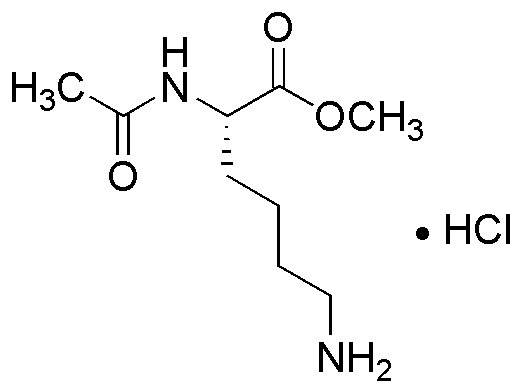Na-Acetyl-L-lysine methyl ester hydrochloride is widely utilized in research focused on:
- Biochemical Research: This compound serves as a valuable tool in studying protein acetylation, which is crucial for understanding gene expression and cellular processes.
- Pharmaceutical Development: It is used in the formulation of drugs aimed at treating metabolic disorders, leveraging its role in amino acid metabolism.
- Cosmetic Applications: The compound is incorporated into skincare products for its moisturizing properties, enhancing skin hydration and texture.
- Food Industry: It acts as a food additive, contributing to flavor enhancement and preservation, particularly in protein-rich foods.
- Nutritional Supplements: This chemical is included in dietary supplements to support muscle recovery and overall health, appealing to fitness enthusiasts and athletes.
General Information
Properties
Safety and Regulations
Applications
Na-Acetyl-L-lysine methyl ester hydrochloride is widely utilized in research focused on:
- Biochemical Research: This compound serves as a valuable tool in studying protein acetylation, which is crucial for understanding gene expression and cellular processes.
- Pharmaceutical Development: It is used in the formulation of drugs aimed at treating metabolic disorders, leveraging its role in amino acid metabolism.
- Cosmetic Applications: The compound is incorporated into skincare products for its moisturizing properties, enhancing skin hydration and texture.
- Food Industry: It acts as a food additive, contributing to flavor enhancement and preservation, particularly in protein-rich foods.
- Nutritional Supplements: This chemical is included in dietary supplements to support muscle recovery and overall health, appealing to fitness enthusiasts and athletes.
Documents
Safety Data Sheets (SDS)
The SDS provides comprehensive safety information on handling, storage, and disposal of the product.
Product Specification (PS)
The PS provides a comprehensive breakdown of the product’s properties, including chemical composition, physical state, purity, and storage requirements. It also details acceptable quality ranges and the product's intended applications.
Certificates of Analysis (COA)
Search for Certificates of Analysis (COA) by entering the products Lot Number. Lot and Batch Numbers can be found on a product’s label following the words ‘Lot’ or ‘Batch’.
*Catalog Number
*Lot Number
Certificates Of Origin (COO)
This COO confirms the country where the product was manufactured, and also details the materials and components used in it and whether it is derived from natural, synthetic, or other specific sources. This certificate may be required for customs, trade, and regulatory compliance.
*Catalog Number
*Lot Number
Safety Data Sheets (SDS)
The SDS provides comprehensive safety information on handling, storage, and disposal of the product.
DownloadProduct Specification (PS)
The PS provides a comprehensive breakdown of the product’s properties, including chemical composition, physical state, purity, and storage requirements. It also details acceptable quality ranges and the product's intended applications.
DownloadCertificates of Analysis (COA)
Search for Certificates of Analysis (COA) by entering the products Lot Number. Lot and Batch Numbers can be found on a product’s label following the words ‘Lot’ or ‘Batch’.
*Catalog Number
*Lot Number
Certificates Of Origin (COO)
This COO confirms the country where the product was manufactured, and also details the materials and components used in it and whether it is derived from natural, synthetic, or other specific sources. This certificate may be required for customs, trade, and regulatory compliance.


